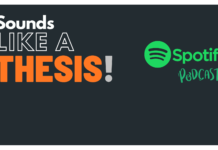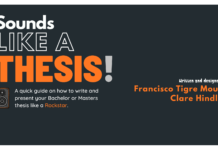This article was updated on 07.10.2021.
Are you a marketing Bachelor, or possibly Masters, student trying to develop an idea for your thesis? Perhaps you already have an idea for the research project but you don’t know exactly how to structure it?
Well, please don’t tell me you are sitting on your couch squeezing your brain hoping that some interesting and meaningful idea will come out. That is certainly NOT how it works!
But don’t worry. After some years supervising (MANY) students, I’ve sketched here some hacks that hopefully will be useful for you!
But please note: These are my personal suggestions. Some scholars may have different views. So don’t forget to discuss your marketing research ideas with your supervisor, ok?
Are you ready? Let me take you through, step-by-step on how to develop a fantastic marketing thesis idea:
The very first aspect you must have clear, in order to structure your thesis idea, is to understand the difference between CONTEXT and THEORY.
This is extremely important and something students very often get wrong. After understanding the difference between them, then we’ll discuss how to define your thesis idea, ok? So here we go, one concept at a time:
First let me ask you a simple question: what would you like to conduct a study on?
Are you interested in conducting a study on electric cars? smartphones? music concerts? children under five years of age? organic food? elderly consumers? fast-fashion? Germans? Australians?
Well, well, well… These are all examples of CONTEXTS in which a study can be conducted!
In a study, CONTEXTS are scopes to which a study can be applied. It does not reveal what the study will be about, neither what it is investigating.
Contexts of study can (or should) be narrowed to, for example:
-
- Sample (Consumer group): e.g. High income, Seniors, Loyal customers, Innovators.
- Product/service category: e.g. Beer, Headphones, laptops, Coffee.
- Markets: e.g. Brazil, Australia, Germany, USA.
You see, the more specific you define your context, the clearer your study will be!
So, for example, you can define your context based on all three scopes: sample, market and product/service category. Here are two examples:
-
- Example 1: You can conduct a study involving Adults (Sample), China (Market) and Luxury cars (Product category).
- Example 2: You can conduct a study involving Bachelor Students (Sample), New Zealand (Context of market) and Hostels (Service category).
Also, you can choose more than one context of sample, market or product. Usually when this is done, the study involves comparing the different markets, samples or products. And these tend to be very interesting studies!
Here is one example of a study, which would compare two contexts:
-
- Example: A study comparing three consumer groups (low income, medium income and high income) in relation to household energy use (Service Category) in Germany (Market).
Seems interesting, right?
Ok, I feel you have understood what a context is. But what if you do not even have an idea of which context to study? Would you like to know how to choose the context(s) of your study?
SIMPLE.
First thing to consider is your personal passion. My friend, what are you passionate about? I mean really PASSIONATE! Is it coffee? submarines? video-games? fashion? food? traveling? No matter your passion, you can always research it in order to understand it and be even closer to it. Pretty good, right?
-
-
- Remember, your thesis will take a lot of effort. Do you really want to discuss and spend loads of time reading about something you are not fond of? Of course not. So follow your passion. Sounds cheesy, but it is true.
-
Second aspect to consider, is the relevance of the study. How timely is the context that you chose? For example, currently there are many relevant topics that are of interest to many people: global warming, virtual reality, artificial intelligence, sustainability…
There are also topics that will always be relevant, no matter the time. So make sure to choose contexts that are relevant for society and that can provide interesting insights for the industry.
An interesting way to find relevant timely topics is to simply visit credible sites and read what the main discussion topics are around the context you are interested in. The list of possible sites is endless, but here are five great examples:
Finally, you might ask yourself: what if my passion is outdated? Well, well, well… In case you are interested in researching old typewriters or coal as a possible source of energy, I’ll leave you to discuss it with your supervisor.
But there is always a way to link to a current topic or adjust to frame it into a research topic.
All good with understanding context? Great! So let’s move on!
In case you are enjoying the article, you can also watch the thesis writing video with further support on how to develop your research idea. On the video series you will also find support on all other chapters of your thesis!
In case you would like to have more research suggestions, check our research resources section.
Ok, so let’s assume you chose Adults (Sample), China (Market) and Luxury cars (Product) as CONTEXT for your study. Very good start!
The following step refers to addressing the question:
WHAT would you like to understand/research about adult Chinese consumers of luxury cars?
Answering this question will allow you to define which theoretical concepts must be defined. For example:
-
- Would you like to understand their perception of quality of cars?
- Do you wish to understand their willingness to buy luxury cars?
- Perhaps how they evaluate car options during their decision making process?
- Maybe how they try to reduce the perception of risk while searching for information?
- Do you wish to investigate their post-purchase evaluations?
- Or maybe how branding and situational factors influence their decision making process?
All of the concepts highlighted are examples of theoretical concepts (your entire literature review will be about them). So defining them is crucial for you to define what your thesis will be about.
And how do you choose your theoretical concepts? How do you know which concepts apply to the context of your study?
Well, the first step is to read previous scientific studies related to the context of your study. By doing so, you will familiarize yourself with what has been researched and identify research gaps related to your context.
And how do you find such studies? Also simple:
-
- Google Scholar: Google Scholar is perhaps the easiest way to start. You simply use keywords related to your context to start with. Go through (this means reading!) the studies and see which concepts have been already applied by other researchers.
- Digital library of your university: Most universities have their internal system of digital catalogues. Does your university have a digital library? Access the scientific journals!
- Search for research gaps: Most scientific studies provide (in their last section) ideas of future research directions. You may choose to develop a study suggested previously by those authors (and make sure to contact them and inform! They will appreciate it!).
Once you have defined the context of your study and the main theoretical concepts, the next step involves defining your research aim.
The research aim represents a general statement which describes what your study “aims” to achieve. Got it? It will be included in the introduction chapter of your thesis and is really important because it should inform the reader what your study will be about.
Here are some further hints when developing your research aim:
-
- The research aim is a statement, which ideally should be ONE (TWO maximum!) sentences long.
- Therefore, it should be short, objective and clear, enabling readers of any audience to understand what your study will be about.
- Also, your aim should ideally include your research context (s)
- Sample: Which consumer group (s) will you address?
- Market: Which market (s) will you address?
- Product/service: Which product (s) will you address?
-
- Finally, your research aim should also include (or provide clear indication of) the main theoretical concepts applied to your study.
- Example of theoretical concepts: Quality, trust, decision making process, willingness to purchase, risk, innovation, satisfaction, loyalty, etc.
- Finally, your research aim should also include (or provide clear indication of) the main theoretical concepts applied to your study.
Here are three examples of research aims, combining all of the suggestions above:
-
- Example 1: This thesis aims to investigate the influence of virtual reality (context of product) on the decision making process (theoretical construct) and willingness to book (theoretical construct) of senior travelers’ (context of sample and service) in Germany (context of market).
-
- Example 2: This thesis aims to investigate and contrast the impact of toy (context of product) advertisement on television (context of medium) on American (context of market) children’s and parents’ (context of sample) trust, willingness to purchase and quality perception (theoretical concepts).
- Example 3: This thesis aims to compare Brazilian and Chinese millennials’ and baby boomers’ (context of sample) usability and risk perception (theoretical context) towards different mobile technology devices (context of product).
Alright, so by now you have understood the difference between context and theory, and how to develop your research aim. Once you have that, the following step is to define your research objectives.
The objectives represent the main steps you need to go through in order to fulfill your research aim. So basically, the objectives are the overall steps of your study.
Essentially, here the logic of your research objectives: You should develop them in a way that after addressing all of them, you will have fulfilled the research aim of your thesis.
Did you understand? My friend, in case you have not understood, please read the the previous sentence as many times as possible until you do. It’s very important you do!
Now that you got it, here are some further recommendations on how to develop your research objectives.
First, there is NO specific number of objectives that your thesis should have. It depends on each project. Furthermore, usually, the FIRST objective refers to the review of scientific literature of the main theoretical concepts of your thesis. Here are three examples to illustrate it:
-
-
-
- Example 1: The first objective involves the review of the relevant scientific literature regarding the concepts of decision making process and willingness to book in the tourism context.
- Example 2: The first objective of this thesis involves reviewing the relevant scientific literature regarding trust, willingness to purchase and quality perception.
- Example 3: The first objective of this thesis involves reviewing the relevant scientific literature regarding usability and risk perception.
-
-
Also, usually, the following second, third, fourth (or more) objectives of your thesis will describe the DATA COLLECTION process of your thesis. Thus, these research objectives should provide an indication of what you want to achieve the data collection processes.
Here are three examples:
-
-
- Example 1: A structured survey will be conducted with senior travelers in order to identify the frequency of service failures during online booking.
- Example 2: A focus group will be conducted with senior travelers to discuss their online booking behavior and identify the main elements which may reduce usability and enhance risk during their online booking process.
- Example 3: An experiment will be conducted to investigate the influence of different mobile technology devices of senior travelers’ usability and risk perception during their online booking process.
-
But pay attention: each step of data collection should be described as a SEPARATE objective. Ok?
And to finish off, usually the FINAL research objective should involve managerial recommendations you have developed based on the findings of your study. It should focus on what companies and managers should do, based on the implications of your findings. Here is an example of a final objective:
-
-
- Example: Lastly, this thesis will provide clear and applicable managerial recommendations for travel agents, tourism professionals and academics on how to better assist senior travelers during their online booking process.
-
My dear friend, glad you made it all the way until the end! Well done. You definitely deserve a cold beer outside, listening to the great Bob Dylan. Only this way you will be able to process all the information and reflect on your own thesis idea.
But before you go get your cold Hop House 13 (my favorite beer) on the fridge, let us go through my main recommendations for you in this article:
-
- First, define the context of your study. It should be both relevant for the industry, but also part of your passion.
- Second, define the theoretical topics for your study. It should be based on the review of previous scientific literature, and logical to what you want to achieve with your study.
- Third, define the aim of your study. It should include context and theory, and be very clear and concise.
- Finally, define the research objective of your thesis. Make sure that you developed your objectives in a way that by completing all of them your aim will be fully addressed.Also, the the first related to the review of the literature, the next ones refer to each stage of data collection and the final related to managerial recommendations.
And my final recommendation is: Don’t forget to discuss all details with your supervisor. What I have written here are solely my recommendations and academics often have different views.
Oh, one very final tip for the meeting with your supervisor:
-
-
- Bring a coffee. Caffeine helps the flow of creative ideas. And in case I’m your supervisor, please bring cappuccino with brown sugar. Never tea (tastes like hot water to me).
- If your supervisor makes any jokes, laugh as if you liked them. Jokes from academics are hardly ever good, but being silent will make it even more awkward.
-












